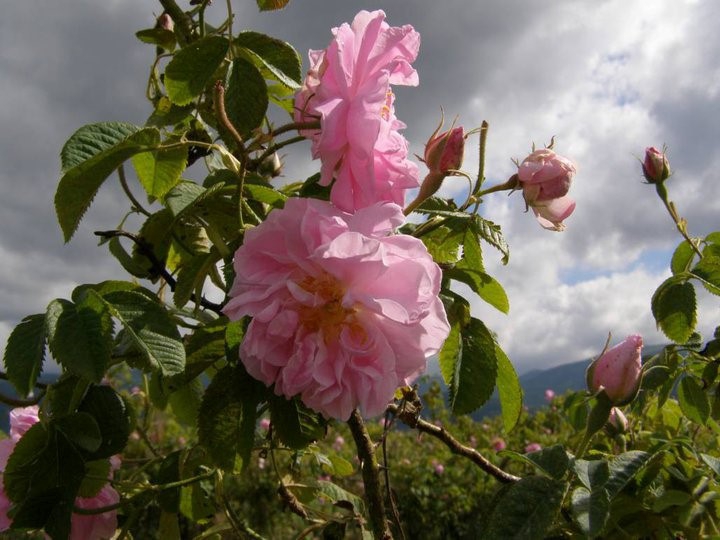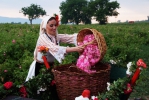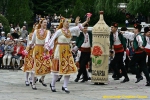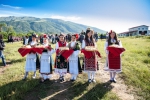Excursions in Bulgaria |
Route: Sofia- Kazanlak- Stara Zagora - Plovdiv - Sofia
Dates:
7 days / 6 nights
transport: bus
price: 0
Dates:
7 days / 6 nights
transport: bus
price: 0
The offer is valid for reservations till May 22 /2022. The period of the visit from May 15 till June 15.
Bulgaria – the country of legends for gods and heroes is as well a country of the famous rose oil. This tour gives the opportunity to visit the Rose Valley, to smell the rose oil perfume, to take part in rose pickings in small villages, to visit a traditional rose distillery and get acquainted with the enigmatic Thracian civilization and the eternal Bulgarian folklore. And last but not least – to visit Bulgarian capital Sofia and one of the most ancient cities in Europe – Plovdiv.
The Rose Festival in Pictures
Day 1– Arrival to Sofia.
Arrival at Sofia airport. Transfer to the hotel. Accommodation at the hotel. Dinner. Overnight stay in Sofia. (If the flight arrival is in the morning or by noon it is possible to make the Day 1 the sightseeing program of Day 2 and to make in Day 2 full day excursion to Boyana Curch and Rila Monastery).
Day 2
Breakfast. Sightseeing tour of Sofia – St. Nedelya Cathedral, St. George Rotunda, Banya Bashi Mosque, Sofia Synagogue – the largest synagogue on the Balkan peninsula, the Presidency and the seat of the Government, Ivan Vazov National Theater, the former Royal Palace, Russian Church of St. Nicolas, St. Sophia basilique, St. Alexander Nevsky Cathedral, National Assembly Square with the monument of the Russian tsar Alexander II named “King Liberator”, Sofia University and National Library.
If the sightseeing program is made the Day 1, this day you will have full day excursion to Boyana Church and Rila Monastery. Boyana Church, located on the outskirts of Sofia is a true masterpiece of the Bulgarian Middle Ages and the avant-garde of the European Renaissance. Its frescoes dates from 1259 year and it was declared by UNESCO a World Cultural Heritage. The Rila Monastery is the largest monastery in Bulgaria. Founded in the 10th century, the Rila Monastery is regarded as one of Bulgaria's most important cultural, historical and architectural monuments and is a key tourist attraction for both Bulgaria and Southern Europe. It is UNESCO site.
Dinner. Overnight stay in Sofia.
Day 3 Sofia - Kazanlak - Stara Zagora
After breakfast we start our journey to world famous Rose Valley.
The Rosa Damascena, known as the Damask or Castile rose, is the greatest treasure in the region of Kazanlak and it is one of the nation’s symbols of Bulgaria. Under the influence of the country’s unique climate and soil, this rose gradually developed into a Bulgarian strain distinct from Damask roses elsewhere. That is why at the beginning of the 19th century this rose was named the Kazanlak Damask rose and the valley to the south of the Central Balkans came to be known as the Valley of the Roses. Here is produced 80% of the world production of rose oil, which is in the base of the highest quality perfumes. For centuries, roses have been the basis for the livelihood of this region.
Arrival in Kazanlak at 11 h. Kazanlak is the center of the Valley of the Roses, the home of the Thracian kings, and an attractive tourist destination. The country’s largest and best preserved Thracian tombs are found here, and they are included among the UNESCO World Heritage Sites, along with the Museum of Roses. At 11 h visit of the “The bread of the Bulgarians: ritual, customs and faith” – exhibition and tasting of traditional bakery products, park Rosarium /Only for 30 May (the date to be cofirmed)/ or visit of the only museum in the world, dedicated to the oil-yielding plant – rose. The Museum of the Rose is housed in the old building of the Rose Institute. The rose is one of the symbols of Bulgaria.The Rose Museum stores more than 15 000 exponents related to rose-picking and rose-production in Bulgaria.
At 12 h - Free time for lunch.
At 15 h visit of the “Kazanlak Tomb” dated 4th – 3rd century BC. It is UNESCO site under a special storage regime. Its duplicate, constructed in scale 1:1, which presents the architecture, the archaeological materials and the wall-paintings of the Kazanlak Tomb, is situated next to the original. This Tomb is one of the most significant monuments of the Thracian culture in the Bulgarian lands. The Thracians are an enigmatic people created a remarkable civilization in the time of the constriction of the pyramids in Egypt. Over 15 000 Thracian tombs have been discovered on the territory of Bulgaria. They are 2000 – 3000 years old. Many of them are situated in the Valley of Roses and this is the reason this valley to have a second name – the Valley of the Thracian Kings.
At 16 h visit of the International Folklore Festival taking place on the central square (available on June 6 and June 7 only).
At 17 h departure to Stara Zagora. Check- in at the hotel. Overnight.
Day 4 – Stara Zagora – Kazanlak – Stara Zagora
Breakfast. Departure to a village to take part in the rose picking ritual (at 9 h a.m.). /The village depends on the program of the rose festival. It could be one of the following villages: Razhena, Kanchevo, Gorno Izvorovo, Gorno Cherkovishte, Rozovo, Tarnichene, etc./
At 12 h free time for lunch in Kazanlak.
At 13,30 h visit of the ethnographic complex “The Tower”with tastings of jam rose petals jand rose liquor.
At 14,30 departure to Stara Zagora. Walking tour of the city. Visit of The Neolithic Dwellings Museum. It contains finds that are extremely important for the history of mankind. It exhibits the two best-preserved Neolithic dwellings in Europe that date back to the 6th millennium BC. Visit of The forum of the antique Roman town Augusta Trayana. It is an archaeological site in the central part of the town of Stara Zagora. The antique forum complex is one of the most monumental installations in the Roman town of Augusta Trayana. The founder of the town was Emperor Trayan (98 - 117), where the name of the town comes from. Time for explore the city. Overnight.
Day 5 – Stara Zagora – Kazanlak – Plovdiv
Breakfast. Departure to a village and take part in the rose picking ritual (at 9 h a.m.). /The village depends on the program of the rose festival. It could be one of the following villages: Razhena, Kanchevo, Gorno Izvorovo, Gorno Cherkovishte, Rozovo, Tarnichene, etc./
Free time for lunch in Kazanlak.
At 14 h 30 visit of “Goliamata Kosmatka”- one of the most interesting Thracian tombs. Archaeologists reveal it several years ago. It is the tomb of the Thraciann King Seuthes III. This monument of the Thracian civilization is 2500 years (5th century BC). There are questions about its construction, which still awaits an answer.
At 15 h 30 departure to Plovdiv. Free time to enjoy the vibrant life of this ancient and modern city. Overnight.
Day 6 – Plovdiv
Plovdiv is one of the oldest cities in Europe – the beginning of its history dates back to 4,000 years BC. In the beginning the ancient settlement was situated on the natural elevation between Nebet, Taksim and Dzhambaz hills (the Three Hills).The visit of Plovdiv includes 2 parts : “On the Roman Path” and the visit of the Old town of the city. The walking tour includs visit of the Roman Forum and the Odeon. The Forum complex is the largest in Bulgaria. It was built in the end of the 1st century AD, when Philipopolis obtained a new city planning scheme and a center (forum) according to a Roman model. The Odeon is situated in the northern part of the Forum. The ancient Odeon has 300-350 seats and served as a domicile of the City Council in Philipopolis. The antique stadium in Plovdiv was built according to the model of the Delphi Stadium – only 12 of this kind are preserved in the world. It is approximately 200 meters long; only its northern part and a part of the fortified wall from the 2nd – 4th century have been exposed. Sports contests were conducted here in the past, as well as gladiator fights and animal fights – the renowned Pitian, Alexandrian and Kendresian games. The Antique Theater in Plovdiv was built in the beginning of the 2nd century AD during the ruling of Emperor Trayan (98 – 117 AD). This antique theater was used to accommodate 5 to 7 thousand viewers. Old Plovdiv Architectural Reserve is a well-preserved complex where on a relatively small area visitors can take walks through different historical ages, see ancient buildings adapted to the modern way of life and feel the spirit of the town from the Bulgarian Revival Period.
Time for explore the town and for shopping. Dinner with traditional Bulgarian meals and folklore program. Overnight in Plovdiv.
Day 7 – Plovdiv - Sofia
Depending on the time of the flight, departure from Plovdiv to the airport of Sofia.
Rates and Participants
Price varies by number of participants and by date of travel. Contact your travel agent.
The price includes:
• 2 overnights in hotel 4* in Sofia
• 2 overnights in hotel 4* in Stara Zagora
• 2 overnights in hotel 4* in Plovdiv
• Transportation with comfortable air-conditioned minibus/bus
• 6 breakfasts
• 6 dinners (no beverages)
• 1 participation in rose picking
• Walking tours of Sofia, Stara Zagora, Plovdiv.
• Entrance fees according to the program in Sofia, Kazanlak, Stara Zagora and Plovdiv
• English speaking guide
The price does not include:
• Not listed meals and beverages
• Entrance fees for museums/ monuments
• Personal expenses
The consequence of the program could be changed depending on the program of the Municipality of Kazanlak.










